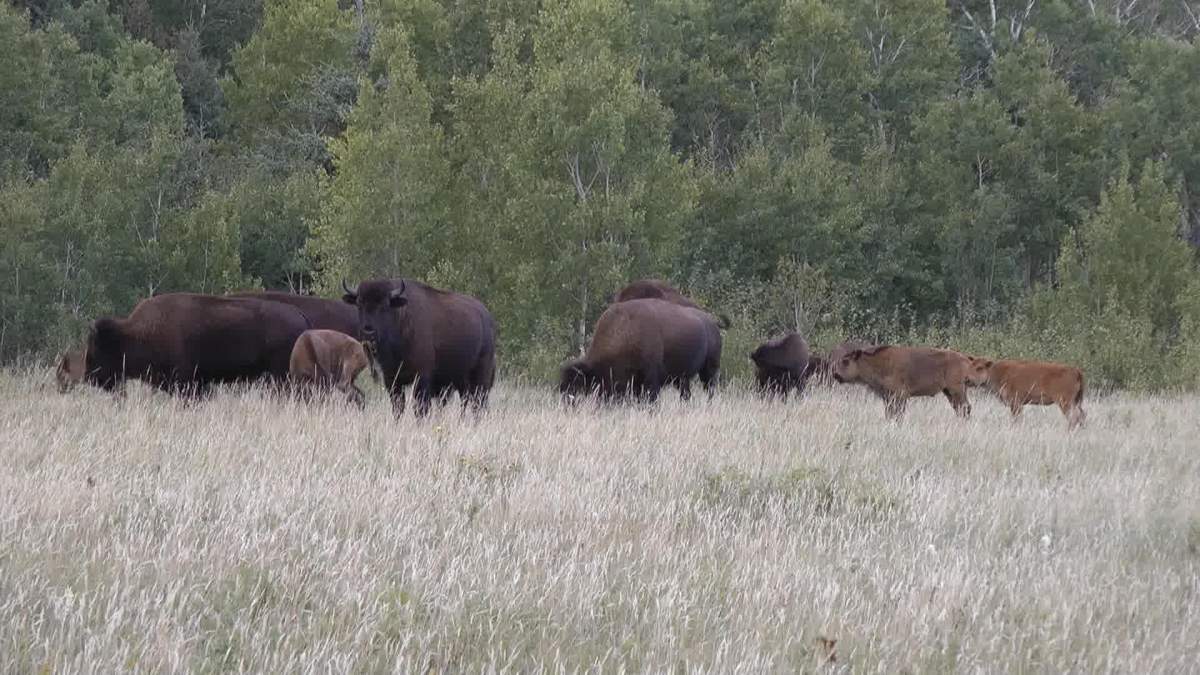Parks Canada says the Sturgeon River plains bison herd in Saskatchewan is seeing signs of growth.

According to wildlife ecologist Digit Guedo, it’s one of three free-ranging herds in Canada and tends to spend roughly 70 per cent of its time within the southwest corner of Prince Albert National Park.
“Having bison on the landscape here was a total horseshoe … as we know bison were nearly extirpated, almost extinct, were gone from the system for over 100 years upon colonization,” she said.
“In 1969 … about 15 to 20 of the individuals from that initial herd settled into the area. The other ones were hunted or shot or moved to another place because they weren’t wanted.
“And so the fact that we have bison here and they chose to call this place home is extremely fortunate. If we were to do that now and try to get bison here, it would be extremely hard and likely extremely costly to do that. So we are very fortunate that they are here.”
The Sturgeon River herd hit a high with over 450 animals from 2006 to 2008, but has had its struggles since then.

Get daily National news
“We can’t say definitively what’s causing the drop but it’s likely a combination of things. It could be just the anthrax outbreak really beginning to stress the herd, plus an increase in harvesting once those bison leave the park. Changes in climate, all acting together to cause that herd to decline. Since that time, the population has just about doubled, which is a promising sign,” Guedo said.
“In 2008, we had an anthrax outbreak and with that, we saw 29 bison mortalities but we estimate many more than that actually succumbed to anthrax, probably around 65 to 70 individuals.
“Around that 60 (bison) mark, and that was around 2015, 2016 … that’s the first time that really made us step back and say, ‘wow, we need to intervene, we need to come together as a group with folks outside the park, with the government of Saskatchewan, as representatives from Parks Canada and local stewardship groups.’”
Parks Canada said it’s committed to the stewardship of the herd, and is working with partners to reverse the declining trend and conserve the bison.
“You can probably understand that there’s going to be overlapping expectations and uses for that bison herd because it’s not always conservation-minded folks that are at the table to discuss some of these issues,” Guedo said.
“(The bison) out on agricultural land can cause damage to crops and fences and things like that so Prince Albert National Park realized that managing the herd really is a shared responsibility with landowners, with people, the public in general, really trying to incorporate as many people as possible into the shared responsibility and management of the herd.
“There is a deep-rooted respect and need for the bison herd for Indigenous communities that neighbour the park, such as Mistawasis First Nation, Ahtahkakoop Cree First Nation, Muskeg Lake Cree Nation, Big River First Nation, just to mention a few. So we want to work with as many people as possible to make sure that that herd can be sustainable in the years to come and continue to grow.”
These days, the herd is estimated at 120 animals — around double the population in 2015 and 2016.
“What we found now is a few signs of promise that the herd is starting to recover,” Guedo said.
“We’re using the aerial surveys and ground observations to estimate what the herd size is, right now, being that we saw 115 individuals as a group in July gives us reassurance that there really wouldn’t be less than that so we’re estimating the population to be 120 individuals.
“We observed quite a few calves and some juveniles and it’s showing promise that herd is starting to rebound and grow again … it validated a lot of the choices that we make as ecologies.”

With one of their key objectives being to maintain parks for generations to come, Guedo said the plains bison are “ecosystem engineers.”
“Without them on the landscape, it really wouldn’t look like it is today … What we have in Prince Albert National Park is novel and people might not realize how special having that phenomenon is,” she said.
“Although after a (fire disturbance) you might see a lot of black areas, or if you see an area that bison have been using … it might not look as appealing but what you’ll see afterwards is that, really, it creates just the mosaic for different habitats and with different habitat comes more species and more diversity so it’s all very important.”
Guedo said the ideal number for the herd, as determined with partners, is to have 420 to 430.






Comments